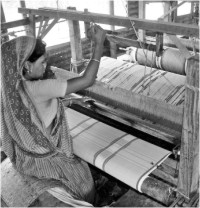| She
From Sirajganj
Women in the Loom Industry
Golam Mostafa Jibon
 A number of women, along with the men of their families are involved in the work of weaving to make their living. They have the training, the cash, the handloom machines and the necessary equipments. They now have a new hope, after the devastation of last year's floods. A number of women, along with the men of their families are involved in the work of weaving to make their living. They have the training, the cash, the handloom machines and the necessary equipments. They now have a new hope, after the devastation of last year's floods.
Three local NGOs: Sirajganj Uttaran Mohila Shangstha (SUMS), the National Development Programme (NDP) and the Manob Mukti Shangstha (MMS) along with financial assistance from the United Nations Development Programme (UNDP) lent their helping hand to the poor weaver families and provided the money and equipment for them to get back on their feet.
“I was hopeless and penniless after last year's floods completely damaged our three handlooms and its necessary equipments. I almost went crazy,” said Kulsum Begum, 35, of Sirajganj district. “I had been spending days in extreme misery with my children for about a year. My sick husband was unable to earn money any other way for our family of six. Due to his disability, I worked in our handloom industry with two other female workers before last year's floods. But the floods took everything we had,” she said.
Later some unknown people introducing themselves as NGO people gave her some cash, three machines of handloom and necessary equipments to continue her business. At present, her three handloom machines are operating again and she is earning the money that her family needs.
Zahurul Islam, 25, of the same village said, earlier he had three handlooms at his house but last year floods washed away his machines along with the equipment. After the recession the floodwater, he went to the doors of banks, NGOs and rich men of the area, but in vain.
“I looked for work but couldn't find anything. My family and I were miserable for a whole year”, Zahurul said.
“Recently, I have installed three handlooms at my house again, as the NGO men gave me money and equipment. At present, two more women of other families work with me”, he said.
Sabura Khatun, wife of Ayub Ali of Har Deghulia village in Shahzadpur upazila of the district said she has taken training and her husband has received cash money, handloom machines and other necessary equipment from the NGO. She now works at her husband's loom-enterprise with two other women. Earlier, she was unemployed and unable to earn money for her family. But now she is working.
Not only Sabura, many like Hosneara, Rahima Khatun, Hurmoti Banu are now working in handloom and changing their fates. They now produce saris, lungis and napkins. The NGOs have given them renewed hope.
It has been learnt from the NGO sources that they provided cash, handloom machines and equipments to the 1220 poverty stricken weavers of the 24 flood affected unions of Kamarkhanda, Raiganj, Belkuchi and Shahzadpur upazilas of the district. Each weaver got a maximum of three handloom machines, necessary equipments and a sum of cash money.
The NGOs also provided rooms to house 1148 ultra poor families of the flood-affected areas. Sirajganj Uttaran Mohila Shangstha (SUMS), the National Development Programme (NDP) and Manob Mukti Shangstha (MMS) implemented the rehabilitation projects involving Tk 37 crore in the flood-affected areas of the district. The total fund was sponsored by UNDP, sources said.
A team of the UNDP led by Ashok Kumar Adhikary, Monitoring Consultant of the Humanitarian Response Team visited the different sites of the rehabilitation projects recently and expressed satisfaction. Ashok said, “Belkuchi, Shahzadpur, Sirajganj Sadar, Kazipur, Ullapara and Kamarkhanda upazila of Sirajganj district are famous for handloom industries in the country. Lakhs of people in the areas had been engaged in the industries for years together. They produce saris, lungis, napkins and other items. More than a lakh people worked on handlooms before the flood. On average about six lakh people of the families were dependent on the profession.”
Of them, many women, teenage girls and boys were involved in the weaving-related work like yarn rolling, cutting and dyeing. The devastating floods washed away and damaged many weaving industries and raw materials, causing huge losses to the loom-owners and rendering thousands of weavers jobless.
After the flood, many poor weavers who were badly affected were not able to restart their loom businesses. Many of them became demoralised after failing to get help.
The allocation of resources, however, might have problems. A big chunk of money was allotted for the Sidr hit area. As a result, they failed to fulfill the needs of the entire flood-hit area of Sirajganj.
Deputy Commissioner of Sirajganj Ashraf Ali said, if different NGOs and social development organisations besides the government comes forward to help and take initiative the pain of the loss from the floods would be a lot less harsh.
Copyright
(R) thedailystar.net 2008
|
